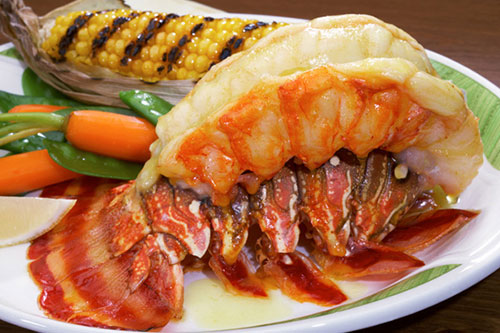|
Fish Factor The link between seafood and loveBy LAINE WELCH
February 07, 2015
In a national survey by Harris Interactive, chefs called lobster an “exotic delicacy that results in an intimate moment because it is hand-held and shareable.” In fact, respondents called all shellfish ‘a catalyst for connection like no other food.’
Lobster, the top Valentine’s Day dish to share with that special someone.
Many ‘experts’ have touted omega-3 fish oils as serious libido lifters because they help raise the amount of compounds that control ‘feel good’ levels in the brain, and stimulate the release of sex hormones. Author Marrena Lindberg also sings the praises of fish oil in “The Orgasmic Diet.” Fish oil, like Viagra, increases nitric oxide levels in artery linings, she claims, which increases blood flow to the brain and sex organs. Seafoods from colder waters contain the most omega 3’s. Pacific oysters pack a special punch at 1700 micrograms, the same as Alaska king salmon. The Alaska seafood with the most omega’s of all? Sablefish. The Salmon Project is spreading the love on Valentine’s Day with special “salmon swag” gift packs created by women whose biggest passion is fish. “We feel like it is a natural holiday for us to help celebrate,” said Erin Harrington, director of The Salmon Project. “One of our brands and one of the key ideas that people really recognize about the Salmon Project is the concept of salmon love,” For the Valentine’s Day promotion, Harrington hooked up with Claire and Emma Laukitis of Homer, aka the Salmon Sisters. They created ‘his and hers’ selections of their popular Salmon Love hoodies for women, and a new Lifeblood t-shirt design for men. “It really speaks to how salmon are the lifeblood of Alaska, and that is something we hear from people over and over again,” said Claire. The Salmon Love packs also include handcrafted salmon soap by Melissa Bravo of Kodiak and salmon rubs from Summit Spice in Anchorage. The Alaska pollock fishery opened on Jan. 20 to trawlers in the Bering Sea and Gulf of Alaska; those fleets also will target cod, perch, flounders and other groundfish. Bering Sea crabbers were nearing 40% of their 61 million pound snow crab quota. About 6 million pounds remain in the 15 million pound Tanner crab catch. A Tanner crab and golden king crab fishery open concurrently at Southeast Alaska on February 13. The Tanner fishery will be assessed after five days to see how many pots are on the grounds. The stocks are looking good, and last year’s take of more than1.25 million pounds was the best in 13 years. The limit for golden king crab is 336,000 pounds. Also at Southeast: the demersal shelf rockfish season opens on Feb. 6. It includes seven different rockfish species with a combined catch of 72,000 pounds. Black rockfish is another catch around Kodiak while jig and pot boats await a state water cod opener in a few weeks. A pot cod fishery opens February 9 at Dutch Harbor to boats under 58 feet. Up next: the halibut fishery opens on March 14; the herring fishery at Sitka Sound should follow soon after. Mix up a batch of manure, flies and fish guts and you end up with a maggot-based meal that’s irresistible to fish. Idaho University scientists (and others around the world) have developed a maggot-based fish feed that also devours manure and fish wastes. Idaho is America's largest producer of farmed rainbow trout, and with a half million cows, it also is the nation's fourth-biggest dairy state. But along with all those cows come billions of pounds of poop. With fish meal prices skyrocketing and mountains of manure piling up, Idaho researchers created something cheaper,that also eats up tons of dung and fish guts in the process. To the rescue -- black soldier flies, used widely in Asia to eat restaurant wastes. In tests by animal waste management engineers, the flies quickly reduced 700 buckets of cow manure by half, and seeded it with their eggs. Two months later, fish guts from local farms were added to the brew to enrich the maggots with omega fatty acids. Then they were cleaned, frozen, ground up and fed to rainbow trout in test stations along the Snake River. The fish snapped up the feed, which made sense to the scientists since flies are a far more natural fish food than corn and soybean-based feeds. Waste engineers believe it could become an important niche industry for Idaho’s dairy farmers who can count on their cows to produce 30 billion pounds of manure each year. American Seafoods Company is accepting applications for its Alaska community grant program. A total of $38,000 will be donated to projects that address hunger, housing, safety, education, research, natural resources and cultural activities. The majority of grant awards range from $500 to $3,000 per organization. Deadline to apply is Feb. 17. Contact Kim Lynch at kim.lynch@americanseafoods.com or 206-256-2659. This year marks the 25th year for this weekly column that focuses on Alaska’s seafood industry. It began in 1991 in the Anchorage Daily News, and now appears in over 20 newspapers and web sites. A daily spin off – Fish Radio – airs weekdays on 30 radio stations in Alaska. My goal is to make all people aware of the economic, social and cultural importance of Alaska’s fishing industry to our state, the nation and the world. Laine Welch ©2015 www.alaskafishradio.com SitNews ©2015 Stories In The News Ketchikan, Alaska
|
||

